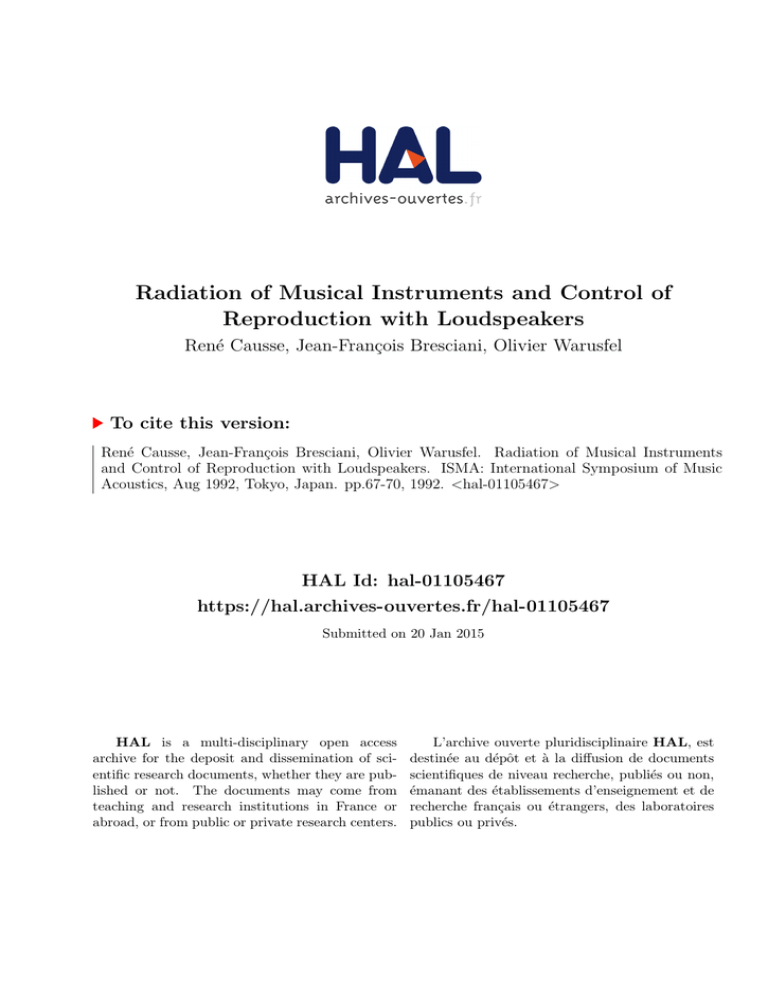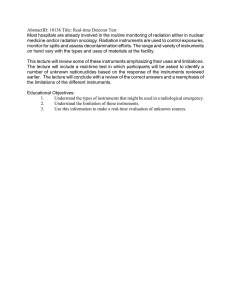Radiation of Musical Instruments and Control of Reproduction with
advertisement

Radiation of Musical Instruments and Control of Reproduction with Loudspeakers René Causse, Jean-François Bresciani, Olivier Warusfel To cite this version: René Causse, Jean-François Bresciani, Olivier Warusfel. Radiation of Musical Instruments and Control of Reproduction with Loudspeakers. ISMA: International Symposium of Music Acoustics, Aug 1992, Tokyo, Japan. pp.67-70, 1992. <hal-01105467> HAL Id: hal-01105467 https://hal.archives-ouvertes.fr/hal-01105467 Submitted on 20 Jan 2015 HAL is a multi-disciplinary open access archive for the deposit and dissemination of scientific research documents, whether they are published or not. The documents may come from teaching and research institutions in France or abroad, or from public or private research centers. L’archive ouverte pluridisciplinaire HAL, est destinée au dépôt et à la diffusion de documents scientifiques de niveau recherche, publiés ou non, émanant des établissements d’enseignement et de recherche français ou étrangers, des laboratoires publics ou privés. Radiation of Musical Instruments and Control of Reproduction with Loudspeakers René Caussé, J.F. Bresciani, O. Warusfel ISMA Tokyo, 1992 Copyright © ISMA 1992 Abstract: Commonly used types of loudspeaker systems have directional patterns that bear no relationship to those of the sound sources which they purport to simulate. The purpose of this project is to derive some parameters linked to the radiation and relevant to our perception. To address this problem, a series of three separate experiments have been conducted: collect data on sound power spectra and directional characteristics of musical instruments to be simulated. build of a multiple drivers reproduction system with signal processing control. investigate the physical and psychophysical properties of this sound source when the directional programming is varied. The influence of the coupling of the sound source and the room on the perception of the simulated sound sources is also examined. 1. Introduction: This project is motivated by the observation that commonly used types of loudspeaker systems have directional patterns that bear no relationship to those of the sound sources which they purport to simulate. This lack of relationship is particularly troublesome when natural sounds are mixed with electro-acoustic sounds (recorded or amplified sounds), "...because the loudspeaker anonymises the actual source..."; "...the instruments, we might say, are sent to the rolling mill of amplification and lose part of their individuality" [1]. Similar effects attract our attention when sounds from synthesis are reproduce with loudspeakers, specially sounds obtained from Physical Model Synthesis [2]. In contrast with traditional synthesis method, this technique provides multi-channel physically significant sound outputs (radiating holes of the clarinet for example) and for which a simple stereo mixing is irrelevant. Our present psychophysical knowledges make it clear that the human observer is sensitive to such deviations, however it is still not possible to characterize the radiation of sound sources, pertinent to the perception. The purpose of this study is to derive some parameters linked to the radiation and relevant to our perception. These parameters will be also function of the acoustic surrounding and of the distance between the source and the listener (differents for the listener at the back of the hall and for the conductor on the stage). 2. Preliminary studies: Preliminary studies done by one of the author [3] have permit to verify the importance of the objective differences of directivity of sources and their noticeable influence on the perception, as well as the problems related to the positioning of the microphone and the informations carry in sound recording. They have shown that an appreciable amelioration is obtain by adding an omnidirectional diffusing system to the principal loudspeaker, which excite the reverberant field of the hall as would do the real instrument, provide that a proper input signal is fed to this complementary device. At this point this work is articulated around four axes of studies in the domain of physical characterization and modelisation of radiation of instruments, perception, sound recording and control of the electroacoustic system of reproduction. The auditory image of a source perceived by the listener is conditioned by the acoustic surrounding, therefore the approach chosen is related to the knowledge acquired in the domain of perception in room acoustic [4]. The psycho-acoustic studies have shown that our perception is structured by a finite number of factors related to room acoustic quality. In the hypothesis of a listener located far from the source and that the room and the source are homogeneous enough; it is possible to consider the level of first reflections as negligible compare to the level of the reverberation field; then the control of the latter and the direct sound provides a good approximation to reproduce the source. 3. Measurement of the power spectra radiated: A good knowledge of the power spectra of the instrument is necessary in order to obtain a good reproduction by the artificial source. The method consists in the measurement of the sound power spectra on twenty points around the source [5], then, after the calculation of the average power, the level (versus frequency) compared with this average and for every microphone is traced. On figure 1, four measurements are shown for two instruments with discrete sources ( 1a for the trombone, 1b for the clarinet holes closed and 1c holes open) and an instrumentbehaving like a wide-spread source (for exemple the violin; 1d). For the clarinet and the trombone it is possible to approximate the measured power spectra by one microphone position among the twenty positions. This is not the case for the violin where strong irregularities are present related to favoured directions. Addition of a simple form like a mute in the bell of the trombone lead to strong irregularities also [6]. 4. Positionning of the microphones: To minimize the influence of the room on the sound recording of the source (and also the signals from adjoining instruments) and to avoid the electroacoustic feedback (Larsen effect) it is necessary to place the microphone close to the instrument, which can also cause interferences. Then we see that the positionning of the microphones require a work of optimisation which is necessarely related to an elaborate knowledge of the radiation of the instruments based on the knowledge of their physical fonctionning. This next step consists first of a measurement of directivity patterns (sinusoïdal excitation and analysis in a cutting plane of the instrument) and second of a modelisation of the source by a spherical harmonics series representation [7], [8]. 5. Reproduction system: To mimic certain types of radiation pattern as a function of frequency, we have build an array of twelve independently programmable loudspeakers mounted on a polyhedral structure (dodecahedron). This reproduction system, equiped with digital signal processing both for piloting and filtering the different channels, constitute the tool to begin this study. The physical characteristics have been measured with the help of the directivity index, which is a relevant criterion for a reproduction system based on the balance between latter and direct sound. At mid frequencies the directivity index varies between 0 and 10 dB [9]. The last step consist on the investigation of the physical and psychophysical properties of this sound source when the directional programming is varied. Particularly is to evaluate the importance from the perception point of view of remarkable behaviour of a vibrating structure like the violin (transition between a monopolar radiation and a dipolar radiation observed on this instrument). 6. Plans for the future: continuation of collecting data and modelisation for different family of instruments. improvement of the electroacoustic source related to the psychoacoustic tests. Integration of the necessary fonctions to simulate the main effects to which the ear is sensitive. study of the case where the first refections are not negligible compare to the level of reverberation process. References: [1] P.Boulez, L'acoustique et la musique contemporaine, 11e ICA, Paris (1983), Vol.8, 213-216. [2] J.M.Adrien, The Missing link, Modal Synthesis, in The representations of sound, the MIT Press (1989). [3] O.Warusfel, rapport interne IRCAM. [4] O.Warusfel et J.P.Jullien, Etude des paramètres liés à la prise de son pour les applications d'acoustique virtuelle, Proceeding of the First French Conference on Acoustics, vol.II C2-877, Lyon (1990). [5] Norm NF S 31-026 [6] R.Caussé, Sourdine et timbre des instruments à vent (Cuivres) dans Le timbre métaphore pour la composition, C.Bourgois Editeur (1991). [7] G.Weinreich and E.B. Arnold, Method for measuring acoustic radiation fields, J.Acous.Soc.Am. 68 (1980), 404-411. [8] P.J.T.Filippi and J.Piraux, Noise source modeling and identification, J.Sound.Vib. 98 (1985), 596-600. [9] G.Chemla, Etude et réalisation d'une source sonore à directivité variable, Rapport Ecole Nationale des Ponts et Chaussées (1989).

